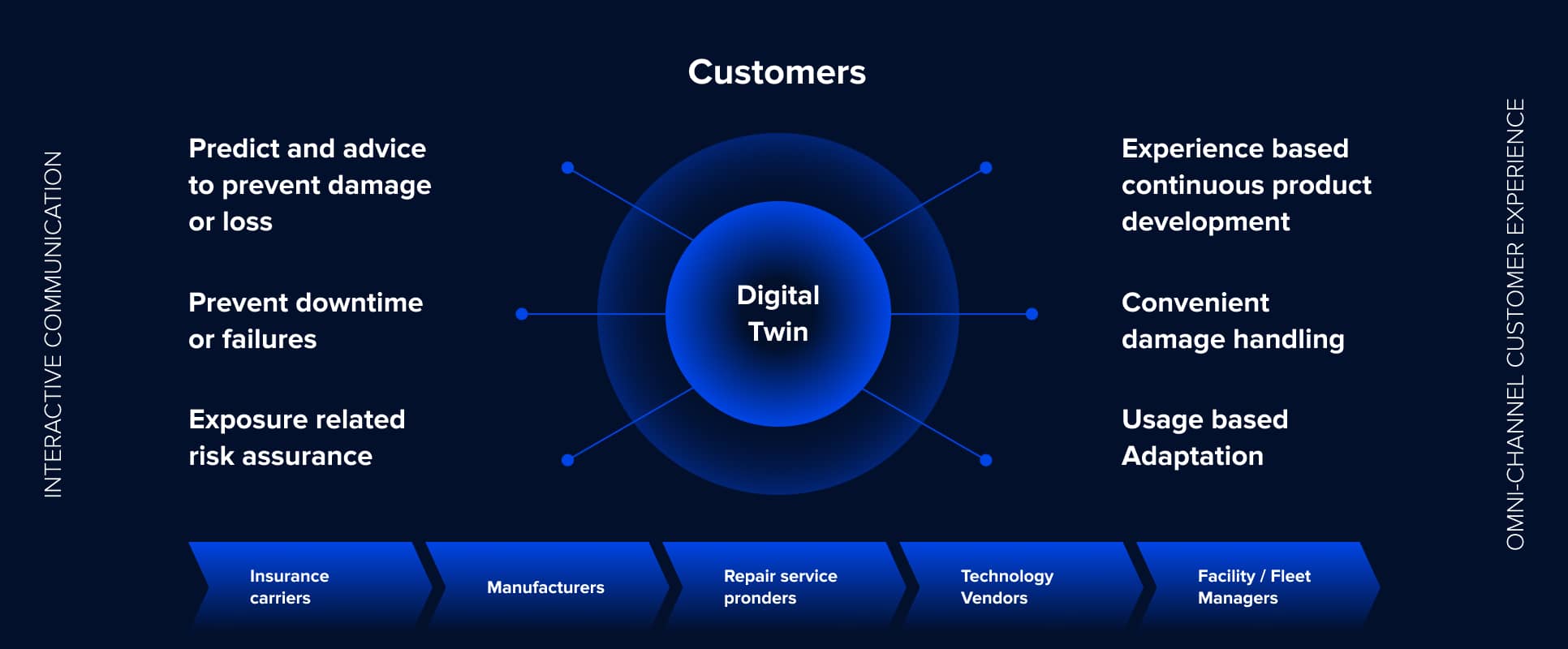We are entering a new digital age, redefining customers' relationships with products and services in the insurance industry. Their behaviour changes and fuels the need for new customer-oriented products, namely faster and more efficient personalised insurance services that provide instant access to data through digital channels. And this is where the insurance software comes in handy.
Insurance companies have rapidly transformed the entire sector using technology as a key competitive advantage. Incumbent companies are also taking quick steps to integrate into this new environment. Therefore, we will consider the most relevant innovative technologies and analyse their impact on basic insurance practices, such as underwriting, insurance pricing, claims processing and fraud detection.
How digital insurance solutions revamp the industry
Let’s look at how innovative technologies are driving the industry's transformation. We’ll focus on three key pillars: IoT (Internet of Things), data management, and digital twins.
- How technologies are improving various aspects of the insurance industry:
-
- IoT data acquisition – InsurTech solutions can be embedded with IoT sensors to collect data from various sources such as vehicles, buildings, wearables, etc. Thin can provide insurers with extensive data like driving behaviour, property conditions and health vitals to ensure a general view of risks and help in accurate underwriting, pricing, and claims management.
- Data insights – Effective data management techniques allow insurers to process and analyse large volumes of data efficiently. Advanced analytics and machine learning algorithms can extract valuable insights from the data collected through IoT devices. These insights enable insurers to identify patterns, trends, and risk factors, improving decision-making processes and enabling more precise risk assessment and pricing models.
- Digital twins to assess risks – By creating digital twins, insurers can simulate various scenarios and evaluate risks associated with insured assets. For example, digital twins of buildings can be used to assess structural vulnerabilities or fire risks. This technology enhances risk assessment accuracy, enabling insurers to provide more tailored coverage and pricing.
- Loss prevention and risk mitigation – Digital insurance solutions can leverage IoT devices to monitor and mitigate risks proactively. For example, sensors can spot problems like water leaks, changes in temperature, or security breaches early on. It can help to reduce potential damage and insurance claims, saving money for both insurance companies and the people who have policies.
- Personalised customer engagement – IoT-enabled devices and data management platforms enable insurers to offer personalised services and engage with customers in new ways. For instance, insurers can give policyholders real-time feedback on customers' driving behaviour or provide customised risk management recommendations. This level of personalisation enhances customer satisfaction and loyalty.
- Claims management and fraud detection – Digital insurance solutions utilising IoT and data management can streamline the claims process. Real-time data from connected devices can automatically trigger claims notifications, initiate the assessment process, and expedite claims settlement. Additionally, advanced analytics can help detect patterns indicative of fraudulent activities, reducing insurance fraud instances.
By leveraging IoT, data management, and digital twin technology, digital solutions can potentially transform the insurance sector. It can lead to more precise risk assessment, elevated customer experiences, and increased operational efficiency.
IoT’s role in the insurance industry
The IoT devices can have a dual impact on the insurance industry. On the positive side, IoT solutions can help insurers reduce risk and enhance personalisation by providing real-time data on customer behaviour, like driving patterns or health and fitness habits. Meanwhile, there are concerns about data breaches and cyber attacks, which could compromise sensitive customer information.
Let’s take a closer look at the positive and negative sides that IoT can have on the insurance industry, as outlined in Deloitte's research.
| Advantages | Disadvantages |
|---|---|
| Data provided by IoT devices can enable insurers to make better risk assessments and lead to reduced number of claims. | With the decrease of the potential risk levels, the need for insurance may also decrease. |
| Besides benefiting from managing risks, insurers can cooperate with manufacturers to proactively minimise potential dangers. | Certain risk pools may become smaller, leading to a potential increase in insurance costs for those seeking coverage. |
| The potential for a significant decrease in the number of losses. | Opting for product liability coverage may be more financially beneficial than switching insurance products due to human error. |
| Offering microinsurance packages and establishing dynamic pricing that can adapt to changing demand. | Privacy and security issues need to be addressed. |
Given that insurance primarily relies on data, any innovation like IoT that enhances data accessibility serves as an efficiency booster for insurance companies. Let’s explore the potential impact of IoT on insurance in detail.
1. Enhanced customer behaviour insights
The traditional methods of determining insurance premiums, such as solely age and car model, are no longer applied. With IoT, insurers can access data like speed and brake usage, preferred routes, and even distractions caused by cell phones. It helps to make more informed decisions about pricing without causing any undue stress.
By having access to a vast amount of data, insurance companies can provide better risk assessment and underwriting processes. It results in happier customers and reasonable premiums.
2. Streamlined claims processing
Efficient claim processing is a crucial aspect of the insurance industry, as it has a direct impact on customer satisfaction and the financial success of insurance companies.
Every year, American consumers lose at least $308.6 billion due to insurance fraud.
Let's continue with car insurance as an example. In the past, submitting an initial notice of loss (FNOL) could be challenging, especially if accidents caused delays in informing the insurance company. This not only increased fraudulent claims but also left customers feeling dissatisfied. However, with IoT, airbags can immediately alert insurers and speed up the FNOL process - leading to happier customers and reducing fraud.
3. Personalised insurance practices
Insurance companies can offer personalised policies without categorising customers into risk groups. It has led to the introduction of pay-as-you-go (PAYG) plans that calculate premiums based on actual usage, resulting in reduced costs if you use your vehicle less often. Such a system offers greater fairness and flexibility to policyholders.
4. Transformation of the insurance landscape
While traditional insurance used to cover risks like house fires, smart homes equipped with telematics can now detect gas leaks and take preventive measures.
This transformation presents both opportunities and obstacles. IoT devices allow for early detection and prevention of potential risks. Meanwhile, some insurers may need to reconsider their strategies to maintain profitability.
5. Data privacy and security concerns
In some cases, IoT devices may collect data that could be attractive to other industries or represent entirely private information to the customer. It raises concerns about data misuse and the possibility of intrusive sales tactics that could negatively impact individuals' privacy and well-being.
The power of IoT data management in insurance
Data management is crucial in helping insurers understand and leverage the information and actionable insights gathered from IoT devices.
Below are key areas that help insurers to make the most out of IoT data management:
- Data acquisition - gathering IoT data from multiple sources, such as wearables, homes, vehicles and industrial equipment, is a complex task, and data management establishes mechanisms to gather such data effectively.
- Data storage - it's common to use cloud-based storage solutions to manage the information produced by IoT devices. However, insurers may also use data lakes or warehouses for storage and future analysis.
- Data governance - encompasses establishing guidelines for managing information, ensuring its high quality, and overseeing it throughout its lifespan. It helps to ensure that the data collected is reliable and easily accessible when needed.
- Data processing and analytics – to gain insights from IoT data, it's necessary to do some preprocessing and analysis. It involves using machine learning algorithms to identify data patterns, trends, and anomalies. Moreover, the processing and analysis are often required in real-time for timely decision-making. Insurers can use stream processing technologies to analyse data once it's gathered - enabling them to monitor events or incidents in real-time while sending alerts if needed.
How digital twins change the insurance sector
The digital twin is the technology that allows the creation of a digital representation of any physical object. With its help, companies can extract "virtual data". The integration of digital twins as a source of information holds great potential for the insurance industry in years to come.
In the past, insurance companies have used historical data to perform risk assessments. But now, thanks to digital twin technology, they can predict and evaluate any potential risks with ease.
The combination of digital twins and IoT encourages insurers to switch to a new approach focusing on preventing or minimising damages rather than simply providing compensation. To gain a better understanding, let's consider an example:
Imagine a smart factory that uses digital twins and IoT technology. The factory’s complex machinery, each equipped with IoT sensors and represented by a digital twin.
Digital twins constantly combine and analyse data that are represented by physical assets, such as temperature, vibration, etc. When a machine has abnormal behavior, special sensors detect it and transfer data to its digital twin. The twin then simulates the potential consequences - how likely the device is to break down and how much fixing or replacing will cost.
Based on those predictions, digital twins can notify the maintenance team when to fix machines so they don't break unexpectedly. It helps keep everything running smoothly and saves time by only fixing things that need it instead of adhering to a set maintenance schedule.
In addition, digital twins can use all the gathered data to identify trends and patterns, which can be later used to improve production processes, save energy, and produce less waste.
To sum up, digital twins can help to improve the following insurance processes:
- Underwriting - more accurate prediction of potential risks.
- Claims processing - facilitated claims processing.
- Fraud detection - duplicating the environment where the damage occurred in virtual space helps to assess whether or not the claim is fraudulent.
Applications of digital insurance solutions for home, life, and auto insurance
Home insurance policies can benefit from various insurance tools and IoT data collection methods to assess risks, tailor coverage, and offer personalised services for customers. Here are some examples:
IoT sensors and smart home devices
With IoT sensors like smart thermostats, water leak detectors, or smoke detectors installed, homeowners can have real-time data on temperature, humidity levels, water leaks and security at the touch of a button. Not only does this provide convenience, but it also ensures that insurers are kept in the loop with any potential issues.
IoT devices offer features such as smart locks, video doorbells and motion sensors that ensure protection against burglaries or break-ins. And that's not all; IoT technology can help older people who need extra assistance in their homes. Fall detection sensors, medication reminders and emergency call buttons can work together seamlessly to ensure peace of mind for both seniors living alone and their families.
Video monitoring and security systems
Video monitoring systems and IoT devices provide real-time monitoring and alerts to homeowners and insurers. It not only enhances security measures, but this technology is a game-changer for insurers operating in disaster-prone areas, enabling them to respond to potential threats and emergencies immediately.
Life insurance policies can be enhanced by using advanced insurance tools and IoT data, which help to evaluate risks accurately, better customise coverage plans according to individual needs, and provide highly tailored services. Allow us to illustrate some examples:
Wearable devices and health apps
Wearable devices like smartwatches and fitness trackers can collect valuable data, including health indicators, activity levels, and sleep patterns. These devices can assess risks accurately, allowing for more personalised coverage options in life insurance policies.
By partnering with health apps or platforms tracking lifestyle choices such as nutrition intake or exercise habits in real-time, insurers can offer personalised coverage.
Digital health records integration
By collaborating with healthcare institutions, insurers can gain a wide view of an individual's medical history and provide tailored coverage options based on accurate risk assessment. With EHR integration, pre-existing conditions and ongoing treatments are considered for more personalised coverage plans.
Auto insurance policies can also benefit from digital solutions. As we mentioned above, IoT devices can help assess driving behaviour. Similar to the benefits it brings for home and life insurance, this technology can customise coverage and provide personalised services. Here's more:
Telematics devices
With sensors embedded in vehicles, insurers can gather real-time data on speed, acceleration, braking and mileage - allowing them to tailor coverage based on actual risk factors.
On the other hand, customers can be rewarded with lower premiums and additional coverage options by practising safe driving habits.
GPS tracking
GPS-enabled devices can be used in auto insurance policies to track vehicles and aid in stolen vehicle recovery. These devices can assist in locating stolen vehicles and recovering them quickly, reducing insurance losses.
Driver assistance systems
Advanced driver-assistance systems (ADAS) in vehicles, such as lane departure warning, collision avoidance and adaptive cruise control, have enhanced road safety for all drivers. Insurance companies can consider the presence of ADAS features when assessing risks and pricing premiums.
It is of utmost importance that insurers must prioritise data privacy and security while gathering IoT data, regardless of which insurance policy is being considered. Insurers must acquire appropriate consent, adhere strictly to data protection regulations, and guarantee open communication with policyholders regarding the use of their data and measures taken to safeguard their privacy.
Key takeaways
Digital insurance solutions are reshaping traditional practices. The statistics echo this statement, with 65% investing in robotic process automation (Deloitte) and 44% prioritising digital tools (McKinsey).
The digital transformation we all encounter redefines customer relationships across industries. Insurers are adapting to this shift, integrating innovative technologies to enhance practices like underwriting, claims processing, and fraud detection.
IoT, data analytics, and digital twins emerge as technological pillars driving change. These innovations streamline processes and foster personalised customer engagement, loss prevention, and risk mitigation. But despite the obvious benefits, concerns regarding privacy and security rise. So, the insurers should pay special attention to safeguarding the sensitive information.
The fusion of technology and insurance is not just a temporary trend—it's a fundamental shift. Embracing digital solutions is no longer an option but a necessity for insurers to thrive in this ever-evolving landscape.
Digital solutions in insurance are the technologies that are aimed at streamlining traditional processes and improving customer experience. These may include a variety of online tools, platforms, and technologies such as automation, customer engagement tools, data analytics software and AI technology or IoT devices.
Digital insurance solutions benefit insurance companies by reducing administrative costs, improving efficiency, enhancing customer experience, and allowing for better data analytics and risk assessment.
For the customers, digital insurance solutions bring streamlined claim processing and 24/7 accessibility of their information and services and more custom-tailored policies.
Insurers are encouraged to adopt digital solutions for the following three reasons:
- Insurers are increasingly turning to digital transformation to differentiate themselves from competitors, providing better customer experiences and more efficient processes.
- Consumers expect seamless digital experiences when buying and managing insurance policies.
- Rising costs due to increased regulation, higher claims payouts, and the need for sophisticated risk management tools can be reduced with digital solutions that automate processes and improve efficiency.


Related Insights


















